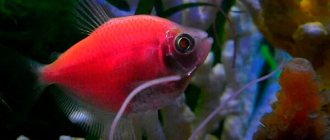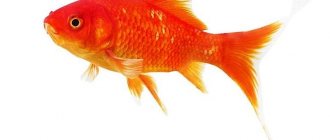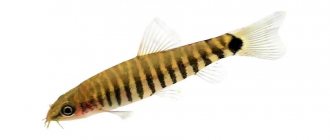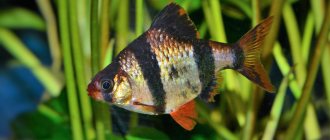Pecilia can be called an ideal option for a community aquarium. This popular fish is distinguished by its unpretentiousness, vitality, beauty and ease of breeding. In addition, there are many varieties of this breed, and although the choice will make your eyes wide open, not a single aquarium lover will be left without a purchase. Platies delight with their appearance and liveliness, so owners really enjoy watching them. But the fish themselves are very inquisitive, they can examine their surroundings and look very funny at the same time.
Habitat of platies in the natural environment
Several species of fish from the carp-toothed family are considered platies. They are bred by both experienced aquarists and beginners. They are often confused with mollies, although these aquarium inhabitants are a variety of them.
The homeland of platies is the regions of Guatemala and Southern Mexico, but today these fish can be found in almost every corner of the planet. They were first bred in Europe in 1907, and almost immediately the breed gained worldwide popularity. Wild platies can be found in the lower reaches of rivers that flow into the waters of the Atlantic Ocean. Individuals living in nature are not as brightly colored as their “domesticated” counterparts.
The main species of aquarium representatives are the southern platy, spotted platy and swordtail. Breeders actively crossed platies with swordtails, so their offspring are quite difficult to identify. Usually, if a fish has a sword-shaped appendage, it means it is a male swordtail, and all other fish, including female swordtails, that do not have this feature, are classified as platies.
The southern highfin platy was first mentioned at the end of the 19th century, the spotted platy in 1904, and the green swordtail only in the 30s. Breeders became interested in these cute fish, and thanks to interspecific crossings, many subspecies of platies appeared. Moreover, you can cross almost any representative of the species.
Spotted platies are often used in work. It was she who became the founder of many breed species with natural colors. But the green swordtail has not been studied so well, and meeting this fish is very rare. It attracts the attention of breeders and, having obtained such a fish, they cross it with swordtails and platies to obtain aquarium fish with an unusual color.
Introduction
The small platie fish is becoming increasingly popular among aquarists.
Aquarium fish lovers appreciate it for its unpretentiousness, ease of keeping and breeding, and for its amazing variety of forms. The name of the fish in Latin is Xiphophorus maculatus. Along with guppies, mollies and swordtails, platies are viviparous.
— Advertising —
The homeland of these fish is considered to be North and Central America, from Veracruz to the center of the USA. Widely known in Colorado, California, Florida and other states where it was introduced by humans.
Pecilia, which lives in natural conditions, is a small fish from 2 to 6 cm long: the female grows up to 6 cm, the male - up to 3 cm. The main body color is light yellow with olive-brown inclusions. There is a dark spot near the tail. The genus of platies has several dozen varieties, which vary greatly in appearance and color.
In aquarium conditions, platies can live 3-4 years.
Description of various types of platies
All platies are modest-sized fish, long ; in an aquarium they live 3-5 years. As for appearance and color, there are many variations - the genus Poecilia includes over 30,000 species, and there are more than 130 aquarium platies alone.
As already noted, the founding species of the genus are the tricolor (southern), spotted and green swordtail. All other breeds appeared as a result of selective breeding. For example, thanks to the hybridization of all the main species, it was possible to obtain the “black platie.” But, unfortunately, today fish of the original breeds are increasingly rare.
Wild fish have a modest color - yellow scales with brown specks. But the inhabitants of the aquarium are by no means shy, and their fiery hue cannot but attract attention. You can find yellow, orange, golden fish and other equally interesting colors and combinations:
- Pecilia balloon. It is considered one of the most interesting representatives of the species. Its peculiarity is a curved spine, due to which the individual has a short and bloated body. Naturally, such a fish does not occur in nature. But the morphological change in structure has a negative impact on reproductive functions; balloon fish often experience various problems.
- Pecilia radish. Already from the name it becomes clear that we are talking about an unusual fish, also artificially bred. It has an unusually shaped rear fin, colored black. Breeders do not stop there, so the “radish family” is periodically replenished with new, original individuals.
- Sailing velifera. This representative of the platie genus is distinguished by its larger size - the length of the fish is 4-7 cm. And it got its name because of its large fin, which looks like a sail.
- Black platie. It may seem that a fish with such a dark color cannot be beautiful, but this is absolutely not true. The black platy is a living, peaceful inhabitant of the underwater world, with luxurious, iridescent scales. Breeders take advantage of this property by crossing it with swordtails.
- Tricolor platie. There are several color variations: platylia is yellow-green and blue, different combinations of black, orange and yellow.
- Red platy. It differs from other representatives in its bright red color, but its fins are blue.
- Disc platie. This fish was named so because of the disk shape of its body. Often, male disc platies are inferior in size to females, and significantly so.
- Pecilia Schwartz. A special feature of this fish is a greenish or yellow stripe on its body. Like other platies, this is an active, non-aggressive aquarium inhabitant.
This is not a complete list; on sale you can find a wide variety of fish, which may also turn out to be platies.
Nutrition
Inhabitants of natural reservoirs eat insects and vegetation. Their aquarium relatives are also unpretentious and can eat almost any food. Owners should consider that their pets should receive plant foods rich in fiber:
- cereals containing plant components;
- pieces of boiled vegetables - cucumbers, spinach, zucchini.
Such food makes up the lion's share of the diet of wild platies; it is necessary for the full functioning of the gastrointestinal tract of the fish. Animal food is also included in the menu - these can be live or frozen bloodworms, brine shrimp, and correts.
Feeding
Natural species of platies are omnivorous; they eat parts of aquatic plants, algae and insect larvae.
When keeping an aquarium, they must be offered:
- Live food - bloodworms, cortera, daphnia moina, aufolophorus, tubifex. This is especially important for platies with bright colors.
- Plant food - zucchini, cucumbers, dandelion, green salad, spinach. Vegetables and herbs should be washed well and chopped finely.
- Dry ready-made food - spirulina and special granules, tablets.
Feed the platie twice a day. The amount of food should be such that after 5 minutes there is no food left in the water. If there is excess, it must be removed.
Occasionally, steamed bread crumb and semolina can be given in small quantities.
It is advisable that the majority of the diet consist of animal feed.
Maintenance and care
Pecilia is a lively, viviparous fish that does not require special conditions. It can live in a small 40-50 liter tank, but it is recommended to release these fish into a larger container. Platies are not aggressive, and even in a flock consisting mainly of females, conflicts do not arise. For 2-3 females, one “gentleman” is enough.
Although there are no special requirements for water parameters, it is still worth sticking to the most comfortable readings:
- water hardness is average – 15-30 dGH;
- acidity 7.0-8.3;
- temperature – from 22° to 25° C.
Clean and fresh water is the key to a long, healthy life for aquarium inhabitants, and platies are no exception. It is recommended to change up to 20% of the water weekly. Filtration and aeration are also worth taking care of, but if there are few inhabitants in the aquarium, these procedures can be omitted.
Diseases
Diseases most often occur only due to improper keeping of fish in the aquarium, when they are not provided with sufficient purity of water, and also due to improper feeding. Platies are usually resistant to various diseases. However, it is still possible for them to become infected with ichthyophthoriosis and parasitic pathologies. Parasites can get into the aquarium with low-quality live food, or if new fish were not quarantined before being placed in the general aquarium.
Compatibility with other fish
As a rule, these fish get excellent company with representatives of related species. In addition, if you populate an aquarium with platies of various species, they can form pairs and reproduce offspring that have new characteristics that are distinctive from other varieties.
Thanks to this feature, even a beginner in the world of aquarium business can turn into a breeder. True, one should not lose vigilance, otherwise the original fry will not be given life by their voracious neighbors. But this property also has a reverse, negative side: males can turn from good comrades into rivals, and the mating season will be accompanied by very severe conflicts.
Another nuance is that platies suffer from cannibalism and can eat their own and their neighbors’ offspring. Therefore, you should take care of a separate tank if the goal is to obtain and raise a litter of new fish. Basically, these fish coexist well with other small inhabitants, peace-loving and non-conflict.
Don't forget about climate preferences. It is not worth settling platies with lovers of warmer or colder waters, the same applies to hardness and acidity. The owner has a choice, since their little charges get along with many aquatic brothers:
- iris;
- scalars;
- guppy;
- zebrafish;
- tetras;
- labeo;
- swordtails;
- cockerels;
- mollies;
- catfish-corridors;
- plecostomus catfish;
- boots;
- discus;
- macropods;
- blue, gold, marble gouramis;
- barbs - Sumatran and bream-like.
These babies do not have such a good relationship with larger, restless, predatory aquarium inhabitants. Eels are also not the best company for them. The following fish are not at all suitable for living in the same tank with platies:
- goldfish;
- cichlids – African and South American;
- large barbs – arulius, crosses, etc.;
- Koi carp;
- mosque mouths;
- astronotuses;
- snakeheads.
If the owner wants to have a well-organized aquatic community where peace and harmony reign, it is worth carefully selecting its inhabitants.
Reproduction
If there are at least two fish of different sexes in the aquarium, then the appearance of fry in most cases occurs without outside intervention and additional preparations. Experienced aquarists claim that stopping the process of reproduction of individuals of this breed is much more difficult than starting. In order for females to reproduce regularly, it is advisable to have 2-3 females and one male. This will save individuals from competition and forced aggression, and females will be spared from the excessive importunity of gentlemen.
Pecilia is a viviparous fish, so a group of formed fry are born, capable of feeding and swimming independently. You can notice that the female is “in position” when her abdomen is significantly rounded. In addition, she has a dark spot near the anal fin - this is the eye of the fry.
Typically, female platies give birth every 4 weeks, with a litter consisting of 20-40 fry. The birth process is simple; it is advisable to place the expectant mother in a separate tank with vegetation. It is worth protecting the female from external irritants by covering the outer glass with a cloth or sheet of paper. The female herself threatens her offspring and can eat the fry, so she must be removed immediately after giving birth, and the surface should be planted with vegetation that will serve as shelter for them.
Caring for young animals is easy, as fairly large and well-formed, viable individuals are born. The fry are fed with crushed egg yolk and dry food; it is best to purchase a special diet for babies. If you provide the young with plenty of feeding and clean water, then after 12 weeks they will turn into sexually mature individuals.
How to distinguish a male from a female
If you look closely at the fish, you will notice that females have a rounded abdomen, a duller color and are larger in size than males. Another distinctive feature is the presence of a pointed small anal fin in the male, the so-called gonopodium. The anal fin of the female is wide, as in the photo below:
Photo: female platie in the last stages of pregnancy
Diseases of Platies
When fish live in a spacious reservoir, in comfortable conditions, and receive high-quality food, they do not get sick. Otherwise, they may develop the following pathologies:
- fin rot;
- fungus;
- infectious diseases.
These exotic representatives of the aquatic world are a real decoration for any aquarium. They do not require any complex manipulations from the owner, but at the same time they deliver a lot of aesthetic pleasure. And if there is a desire to diversify the peace-loving company of small fish, platies are a win-win option.











